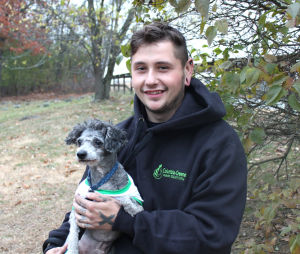 There are plenty of cats and kittens available for adoption at the Columbia-Greene Humane Society/SPCA, all waiting to join their forever families for the holidays. Pictured with Adoption Counselors Jhori Jurgenson and Stephanie Nedwick and Animal Care Technicians Josh Margolias and Zach Kucharek are four of the many wonderful felines patiently waiting for their forever homes. | Happy Thanksgiving to all our readers and animal lovers! The time is here and now to prepare your outside or sometimes-outside dogs for the winter season to follow. Messages about an increase in food and calories must be heeded, as well as making sure that drinking water is always available. Snow is absolutely never a water replacement. Equine heated rubber buckets or de-icers are available at your local Agway or online at www.kvvet.com. Your not-to-be-cold canine shelter needs to be of sufficient size for movement, insulated and ideally in a protected area. Topping an outside kennel with plywood over your doghouse makes an excellent shelter, which gives assurance that dogs are then protected from rain and snow. |
Do not forget that it is against the law for a dog to be outside without sufficient shelter if it is housed outside. Crates are not sufficient and are not law-compliant. Boxes, lean-tos, etc. are no-no’s as well. If you’re tending to feral or semi-feral felines, try to supply an indoor haven. Barns, sheds, garages, outbuildings, etc. with doors cracked open can prevent cats that are on their own from succumbing to freezing temperatures and frostbite.
I have a “rule” that most dogs should be brought in at 20 degrees Fahrenheit. My Husky and Malamute (and Shepherd) friends typically chuckle at this, because most of these breeds are outside snoozing at 0 degrees or below!
Please call our Cruelty Unit if you think a small animal is in jeopardy. Though requirements for equines differ greatly from smaller or large companion animals, most outside horses should have run-in sheds. Many do well without, as long as they have sufficient feed.
I remember racing up to my barn to bring SoFar and Dudley inside during a sleet storm. If you think they wanted in — they didn’t. Those rotund, well-fed bodies were keeping them warm, and they were enjoying the change in the scenery. If you see horses that look in jeopardy, please call us. Many owners are innocent to proper cold-weather management. Others may need to be prosecuted.
Here is the CGHS/SPCA Wish List for Hanukkah and Christmas:
>> Canned dog and cat food;
>> Biscuits and treats for kitties and puppies;
>> Paper towels;
>> Clorox and dish liquid;
>> Blankets and towels (no quilts);
>> Self-adhesive stamps (44 cent or forever);
>> Toys, toys, toys — Kongs, flexible Nylabones, Jolly “Kettle” Balls, Buster Cubes (small and large);
>> Pet-friendly ice melt (Safe Paw or comparable);
>> Loving, caring homes with a small spot for a new companion (or two)!
On a final note, we are currently well-stocked in eager kittens and cats as well as faithful dogs, just waiting to lie next to you during the upcoming holiday season. Without further ado, let me introduce a handful to you — but I’m sure you’ll want to come down yourself to pick one or more!
Sophie and Fiona: After the passing of their owner, Sophie and Fiona found themselves at our shelter, away from the comfort of their home and in an unfamiliar environment. When in their cage, they can be found snuggling one another, completely inseparable as they look to each other for security and comfort. These sisters are strikingly beautiful; their beautiful electric blue eyes complement the silvery hue of their soft fur, and it would be impossible to not fall in love with their remarkably stunning features. Sophie and Fiona are both 2 years old, and would make wonderful companions to any family.
Jacob: Jacob, a Redbone Coonhound, is sure to howl his way into your heart! Jacob is only 11 months old, with a goofy temperament and a hilariously silly attitude. He will need a home that can offer him a lot of exercise and room to run, as he’s still young and has a lot of energy to burn. Being a typical Coonhound, Jacob is sure to follow any scent on his nose, so he will not be an appropriate option if you are looking for a free-range dog. Jacob previously lived with dogs, cats and children, and would be a great addition to any family!
Dash: Left behind by his owners after being bounced from home to home, Dash is a quiet and mellow guy that is sure to steal your heart with his charming disposition and soulful eyes. Most of the staff have found themselves wondering why no one has fallen in love with him yet since he’s a delight to be around, extremely easy-going and very affectionate. Despite being a 1-year-old hound mix, we have not once heard him howl or bark. He is very relaxed, and he greatly prefers the comfort of a couch and a warm lap to a run around the neighborhood. You’ll find him to be a wonderfully calm and loving dog that is sure to appreciate the forever home he so greatly deserves.
Shy: Shy, a 5-year-old Shiba Inu, was cast away by previous owners and left to roam as a stray before being picked up and brought to CGHS/SPCA. Appropriately named, Shy is very timid of new people and situations, and will need a very low-key, mellow home to settle down in. Shy would prefer a home with adults only, as children can be too much for him. He is very handsome and once you gain his trust, he will sneakily snuggle you for affection and politely ask you to play fetch with him. Shy is very sweet, and though it may take some time and patience for him to welcome you into his heart, you’ll be glad you made the effort!
***
Charlene Marchand is the Chairperson of the Columbia-Greene Humane Society/SPCA Board of Directors. She may be contacted by e-mail at [email protected].

 RSS Feed
RSS Feed